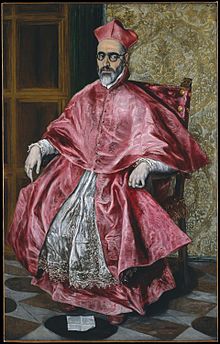Fernando Niño de Guevara
This article has multiple issues. Please help improve it or discuss these issues on the talk page. (Learn how and when to remove these messages)
|
Fernando Niño de Guevara | |
|---|---|
| Cardinal Archbishop of Seville Cardinal-priest of Santi Silvestro e Martino ai Monti | |
 | |
| Archdiocese | Seville |
| See | Seville |
| Installed | 30 April 1601 |
| Term ended | 8 January 1609 |
| Predecessor | Rodrigo de Castro Osorio |
| Successor | Pedro de Castro y Quiñones |
| Other post(s) | Cardinal-priest of Santi Silvestro e Martino ai Monti |
| Previous post(s) | Cardinal-priest of San Biagio dell'Anello (1597-1599) Titular archbishop of Philippi (1599-1601) Grand Inquisitor of Spain (1600-1602) |
| Orders | |
| Consecration | 10 October 1599 by Pope Clement VIII |
| Created cardinal | 5 June 1596 by Pope Clement VIII |
| Rank | Cardinal-priest |
| Personal details | |
| Born | 1541 |
| Died | 8 January 1609 (aged 68) Seville, Spain |
| Nationality | Spanish |
| Denomination | Roman Catholic |
| Occupation | Lawyer |
| Alma mater | University of Salamanca |
| Coat of arms | |
Ordination history of Fernando Niño de Guevara | |||||||||||||||||
|---|---|---|---|---|---|---|---|---|---|---|---|---|---|---|---|---|---|
| |||||||||||||||||
| |||||||||||||||||
Fernando Niño de Guevara (1541 – 8 January 1609) was a Spanish cardinal who was also Archbishop of Seville and Grand Inquisitor of Spain.
Biography
[edit]Fernando Niño de Guevara was born in Toledo, Spain in 1541, the son of Rodrigo Niño, Marquis of Tejares.[1] An uncle, also named Fernando Niño de Guevara (d. 1552), was Archbishop of Granada from 1542 to 1552. He studied law at the University of Salamanca. He then moved to Cuenca, Spain, where he became archdeacon of the cathedral. In 1570, he became an oidor in Valladolid. He became a member of the Council of Castile in 1580.
On 3 December 1599 he was appointed Grand Inquisitor of Spain. During his tenure as Grand Inquisitor, the Spanish Inquisition burned 240 heretics, plus 96 in effigy. 1,628 other individuals were found guilty and subjected to lesser penalties.
On 10 Oct 1599, he was consecrated bishop by Pope Clement VIII with Camillo Borghese, Cardinal-Priest of Santi Giovanni e Paolo, and Alfonso Visconti, Bishop of Cervia, serving as co-consecrators.[1][2]
In 1600 he had a portrait painted by El Greco. On 30 April 1601 he was also appointed Archbishop of Seville.
Fernando Niño de Guevara engaged the Jesuits in a dispute about the nature of papal authority. As a result, Pope Clement VIII prevailed on Philip III of Spain to induce him to resign as Grand Inquisitor in 1602.
He did, however, retain his duties as Archbishop of Seville. In this capacity, he called a synod in 1604 in order to suppress the confraternities and replace them with similar institutions dominated by clerics.
He died, probably in Seville, on 8 January 1609. He is buried in the Convent of San Pablo in Toledo.
Episcopal succession
[edit]While bishop, he was the principal consecrator of:[2]
- Tomás de Borja, Bishop of Malaga (1600);
- Juan Bautista Acevedo Muñoz, Bishop of Valladolid (1601);
- Juan de la Sal, Titular Bishop of Hippo Diarrhytus and Auxiliary Bishop of Seville (1603); and
- Francisco de Vera-Villavicencio, Titular Bishop of Madaurus and Auxiliary Bishop of Seville (1603).
References
[edit]- ^ a b Miranda, Salvador. "NIÑO DE GUEVARA, Fernando (1541-1609)". The Cardinals of the Holy Roman Church. Florida International University. OCLC 53276621. Retrieved 29 February 2016.
- ^ a b Cheney, David M. "Fernando Cardinal Niño de Guevara". Catholic-Hierarchy.org. Retrieved June 16, 2018. [self-published]
- This page is based on this page on Spanish Wikipedia.
